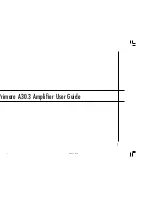
5
Connecting the Amplifier
The inputs and speakers may only be connected when
the unit is switched off!
5.1 Inputs
MIC 1 and MIC 2 (1) Connections for low impedance
microphones
PHONO (13)
Connection for a turntable with
magnet system
AUX/CD (14)
Connection for a unit with line
output, e. g. CD player, tape
deck or turntable with ceramic
system
A Y cable is required for stereo units with two outputs
so that both outputs are led to the corresponding com-
mon amplifier input.
If the turntable has a separate ground cable, connect it
to the GND screw (11).
5.2 Speakers
The speakers can be connected as shown in fig. 3 – 8.
Connect them to the terminals (10) accordingly. Pay
attention to the correct individual resp. total speaker
impedance as well as to the correct phase connection
of the speakers (positive and negative connections, as
shown in fig. 3 – 8). The positive connection of the
speaker cable is always specially marked.
5.3 Priority Switch
1) Finally, connect the amplifier to a power mains sup-
ply (230 V~/50 Hz).
2) If in case of a power failure of the 230 V mains the
amplifier should continue to operate, the power
failure back-up of the amplifier can be connected to
a 12 V rechargeable battery via the terminals
POWER INPUT (9).
6
Operation
1) Turn the MASTER VOLUME control (5) to zero
before switching on. Switch on the amplifier via the
POWER switch (6).
2) Set the PHONO/AUX selector (12) to the AUX posi-
tion. The selector must be set to PHONO position
only if a turntable with magnet system is used.
3) Slightly turn up the MASTER VOLUME control (5).
Adjust the desired volume in relation to each other
via MIC 1, MIC 2 (2), and PHONO/AUX CD (3). Set
all controls which are not connected to a source to
zero.
4) Adjust the tone with the TONE control (4) and the
total volume with the MASTER VOLUME control (5).
5) If desired fade the microphones in and out with the
MIC 1 and MIC 2 (2) controls resp. the music source
with the PHONO/AUX CD control (3).
7
Specifications
Output Power: . . . . . . . . . . 20 W
RMS
, 40 W
MAX
THD: . . . . . . . . . . . . . . . . . 5 % (20 W
RMS
)
Outputs
Speakers: . . . . . . . . . . . 4/8 Ω, 100 V
Inputs
2 × MIC: . . . . . . . . . . . . 3 mV/5 kΩ (for low
impedance microphones)
PHONO: . . . . . . . . . . . . 3 mV/50 kΩ (RIAA)
AUX/CD:. . . . . . . . . . . . 150 mV/3 kΩ
Frequency Range: . . . . . . 100 – 15 000 Hz, ±3 dB
Tone Control:. . . . . . . . . . . -10 dB/10 kHz
S/N Ratio: . . . . . . . . . . . . . > 55 dB
Power Supply:. . . . . . . . . . 230 V~/50 Hz/47 VA or
12 V
extern., 2.5 A
Ambient temperature: . . . . 0 – 40 °C
Dimensions (W × H × D): . 320 × 85 × 230 mm
Weight: . . . . . . . . . . . . . . . 3.8 kg
Subject to technical modification.
Attention!
The total load of all speakers must not exceed
20 W
RMS
when using PA speakers with 100 V audio
transformer (fig. 8), as otherwise the amplifier will be
overloaded. This may result in amplifier damage.
GB
7
All rights reserved by MONACOR
®
INTERNATIONAL GmbH & Co. KG. No part of this instruction manual may
be reproduced in any form or by any means for any commercial use.







































